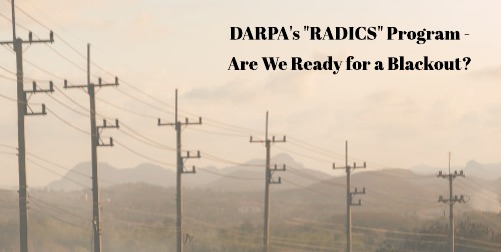DARPA is working on interesting projects for the military, and their RADICS project is simulating blackouts to test responses to a cyberattack on the Country’s power grid

(Prototype of a mechanical spy android, disguised as a housefly)
Getting Online
The Defense Advanced Research Projects Agency (DARPA) has been heavily involved in the technological revolution taking place in the last fifty years or so. The origins of the internet can be traced back to the agency in the 1960s with a paper by the first director of the subagency, the Information Processing Techniques Office (IPTO). The essay’s title was “On-Line Man Computer Communication” and described what would, over the following decades, manifest as the internet. The world’s fastest airplane, GPS, and cloud computing are three more examples that stemmed originally from research at DARPA.
The Future of Military Tech
Recently, the agency has been working on revolutionizing the armed forces in several ways. From exoskeleton suits to enhance soldiers’ strength (and help protect them) to small-caliber homing bullets that can lock onto their targets like some (much larger) missiles, DARPA research is aiming to change the nature of military combat. Although some projects, like the WALRUS blimp for transporting troops, were scratched- others appear to be developing along. Similar to the exoskeleton, an implantable health tracker for soldiers would utilize biotech to monitor the stress and physical condition of soldiers conducting a mission. Miniature bug spies (yes, robot insects that fly around with video cameras) and underwater submarine-hunting drones are two other projects of note that DARPA is working on.
The RADICS Project
Somewhat more importantly, the agency’s RADICS program has been working since 2015 on contingency plans for a widescale attack on the country’s electrical energy system. The “Rapid Attack Detection, Isolation, and Characterization Systems” (RADICS) developed and tested protocols for cybersecurity professionals, power engineers, and first responders in the event of a catastrophic blackout. In 2013, a still-unknown shooter (or group of shooters) damaged 17 electrical transformers in California, costing $15 million in repairs. The sabotage only focused on one transmission substation so a blackout was prevented by rerouting power from nearby Silicon Valley. Although the event went by almost unnoticed by the general public, the attack accentuated the vulnerability of the nation’s power grid, because if multiple transmission substations go out at once, rerouting power is a less viable option. Studies have shown that the worst-case scenario for a long-term, nationwide blackout could result in annihilating 2/3 of the US population. Therefore, because experts think such a widespread, coordinated attack could only be successful if the transmission substations were infiltrated by a cyberattack, not sniper rifles, DARPA commenced their RADICS program to handle such an emergency. FERC (The Federal Energy Regulation Commission) was the federal body responsible for beefing up physical security at these powerplants, while DARPA explored how to handle the hypothetical aftermath of such an event
The Plum Island Exercise
In 2018, the agency simulated one of these blackouts on Plum Island, a federal research facility. Over 100 people took part in the exercise, which attempted to simulate “the uncertainty of a real-world cyberattack that took out power across the nation for weeks on end.” This scenario is referred to as “Black Start.” The simulation’s main goal was to test the digital tools that would be available to get the system up and running, and thus turn the lights back on, while simultaneously getting bombarded with cyberattacks. The RADICS “red team” was responsible for bombardment whereas the “blue team” tested how their tools withstood the attacks. Expiring this year, DARPA’s RADICS program will hopefully never have to be utilized in the real world (the risk of a total system failure was deemed “remote” by a risk assessment study in 2017 that had labeled a global pandemic as “fairly likely”). Two cyberattacks caused blackouts in Ukraine in 2015 and 2016, so the scenario is not as unlikely as it may seem. The existence of RADICS might become the greatest accomplishment by DARPA, if it gets called upon to restore power in a catastrophic power outage and does so, but hopefully it just collects dust.
Until Next Time,

**Written by Benjamin Derge, Financial Planner. The information has been obtained from sources considered reliable but we do not guarantee that the foregoing material is accurate or complete. Any opinions are those of Benjamin Derge and not necessarily those of RJFS or Raymond James. Links are being provided for information purposes only. Expressions of opinion are as of this date and are subject to change without notice. Raymond James is not affiliated with and does not endorse, authorize, or sponsor any of the listed websites or their respective sponsors.

DARPA Blackout Training
